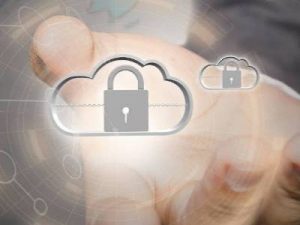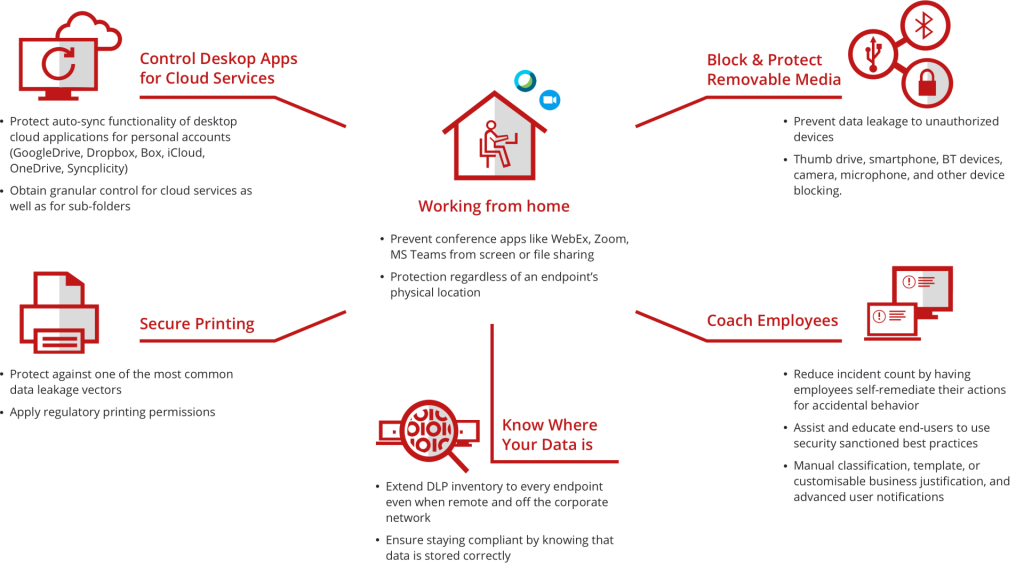Think Beyond the Edge: Why SASE is Incomplete Without Endpoint DLP
Organizations have been in the midst of digital transformation projects for years, but this development represented a massive test. Most organizations were pleasantly surprised to see that their employees could remain productive while working from home thanks to successful cloud migration projects and the adoption of various mobility and remote access technologies, but companies have become more worried that they have far less visibility into data on employees’ systems when they are working remotely. Traditional Network DLP can protect data while it is traversing through the network up to the corporate edge, but it has little visibility to data once it is out of the corporate network and its effectiveness is further limited when the workforce is distributed.

The move to a distributed workforce came suddenly and swiftly. In February 2020, less than 40% of companies allowed most of their employees to work from home one day a week. By April, 77% of companies had most of their employees working exclusively from home.
Cloud-native security is part of the solution
Organizations that employed cloud-based security technologies like a Cloud Access Security Broker (CASB), DLP, or Secure Web Gateway (SWG) could enable their users to perform their jobs with fast and secure direct-to-cloud access. However, this still leads to headaches: IT organizations have to manage multiple disparate solutions, while users face latency while their traffic needs to bounce between multiple siloed technologies before they can access their data.

More than three-quarters of CIOs are concerned with the impact that this increased data sprawl is having on security. Despite the fact that roughly half of all corporate data was stored in the cloud last year, only 36% of companies could enforce data protection policies there. Many organizations therefore forced home-based users to hairpin all traffic back to the corporate data center via VPN so that they could be protected by the network data loss prevention (DLP) system. This maintained security, but it came at the cost of poor performance and reduced worker productivity.
Many SASE proponents posit that the best way to architect a distributed Work From Home environment would be to have all security functionality in the cloud at the “service edge”, while end user devices have only a small agent to redirect traffic to that service edge. However, this model poses a data protection dilemma. While a cloud-delivered service can extend data protection to data centers, cloud applications, and web traffic, there are a number of blind spots:
The Secure Access Service Edge (SASE) presents a solution to this dilemma by providing a framework for organizations to bring all of these technologies together into a single integrated cloud service. End users enjoy low-latency access to the cloud, while IT management and costs are simplified. So everyone wins, right? Not entirely.

Bringing it all together is the key
It’s great to say that to address the challenges of cloud transformation and the remote workforce, existing network DLP solutions – with their dedicated management interface, data classifications, and policy workflows – need to be accompanied by similar capabilities in the cloud, and then again on the endpoint. Of course, that’s completely impractical where IT organizations are already struggling to deal with the status quo due to finite budgets and skilled personnel. Not only is it impractical, but it undermines the consolidation, simplification, and cost reduction promised both by digital transformation and the SASE framework.
- Every remote worker’s home is now a remote office with a range of unmanaged, unsecured devices like printers, storage drives, and peripherals that can be compromised or be used to exfiltrate data.
- Attached devices like USB keys can be used to get data off of a corporate device and beyond the reach of and data protection controls.
- Cloud applications like Webex, Dropbox, and Zoom all have desktop companion apps that enable actions like file syncing or screen/file sharing; these websocket apps run locally on the user’s system and are not subject to cloud-based data protection policies.
These blind spots can only be addressed by endpoint-based data loss prevention (DLP) that enforces data protection policy on the user’s device. This is not dissimilar to how SASE frameworks rely on SD-WAN customer premises equipment (CPE) that perform essential network flow functionality at branch office locations. Therefore, it’s imperative to look for SASE solutions that include endpoint DLP coverage.

To manage data security of a distributed workforce, linking device security to corporate policy becomes extremely important. With a managed DLP agent on the device, IT security can know where sensitive data exists, block untrusted services and removable media, protect against cloud services and desktop apps, and educate employees to potential dangers.
The answer to this dilemma is a comprehensive data protection solution that encompasses networks, devices, and the cloud, something that is uniquely delivered by McAfee MVISION Unified Cloud Edge (UCE). MVISION UCE is a cloud-native solution that seamlessly converges core security technologies such as Data Loss Prevention (DLP), cloud access security broker (CASB) and next-gen secure web gateway (SWG) to help accelerate SASE adoption. MVISION UCE features multi-vector data protection that features unified data classification and incident management across the network, sanctioned and unsanctioned Shadow IT cloud applications, web traffic, and equally important, endpoint DLP. This provides corporate information-security teams the necessary visibility, control and management capability to secure home-based and mobile workers as they access data anywhere.
Centrally managed by McAfee MVISION ePO, McAfee DLP can be easily deployed to endpoints. With its unique device-to-cloud DLP features, on-prem DLP policies can be easily extended to the Cloud with a single click and as fast as under one minute. Shared data classification tags ensure consistent multi-environment protection for your most sensitive data across endpoints, network and cloud. —
Historically, data protection has focused on a central point like the network or the cloud because implementing it on the device has been difficult. However, with McAfee’s Unified Computing Edge (UCE), DLP becomes an easy-to-deliver feature.
To find out more, please visit www.mcafee.com/unifiedcloud.
Incorporating security into the cloud and the edge, and delivering data protection at the endpoint, are the only way to really deliver on what SASE promises and unlock your remote workforce. Looking to the future, a widely distributed workforce is here to stay. Companies need to take steps to secure devices and data wherever they are.
The post Think Beyond the Edge: Why SASE is Incomplete Without Endpoint DLP appeared first on McAfee Blogs.
This post was first first published on Enterprise – McAfee Blogs’s website by Shlomi Zrahia. You can view it by clicking here

